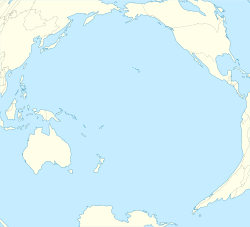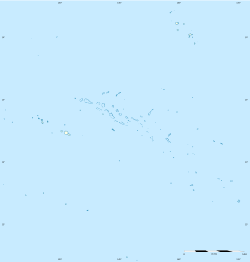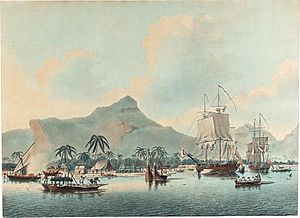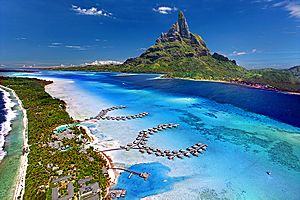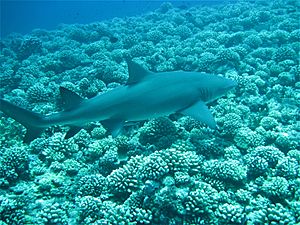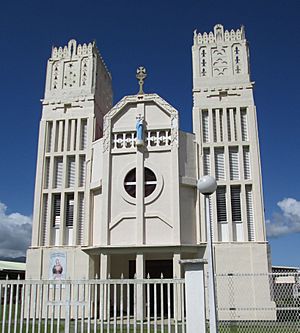Society Islands facts for kids
|
Native name:
Îles de la Société (French) / Tōtaiete mā (Tahitian)
|
|
|---|---|
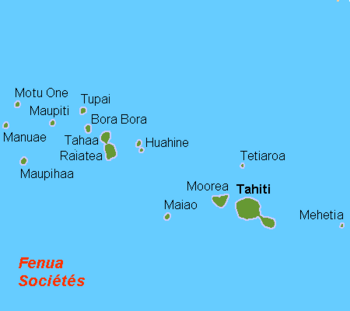 |
|
| Geography | |
| Location | Pacific Ocean |
| Coordinates | 17°32′S 149°50′W / 17.533°S 149.833°W |
| Archipelago | Polynesia |
| Total islands | 14 |
| Major islands | Tahiti, Moorea, Raiatea, Bora Bora, Huahine |
| Area | 1,590 km2 (610 sq mi) |
| Highest elevation | 2,241 m (7,352 ft) |
| Highest point | Mont Orohena |
| Administration | |
| Collectivity | |
| Largest settlement | Papeete (pop. 26,925) |
| Demographics | |
| Population | 275,918 (2017) |
| Pop. density | 148 /km2 (383 /sq mi) |
The Society Islands (called Îles de la Société in French and Tōtaiete mā in Tahitian) are a group of islands in the South Pacific Ocean. They are part of French Polynesia, which is a special overseas country of France. These islands are also part of a larger group of islands called Polynesia.
Captain James Cook is thought to have named these islands in 1769. He might have named them after the Royal Society, a group that helped pay for his trip. But Cook also wrote in his journal that he called them "Society" because they were close to each other.
Contents
History
Early Settlers
The first people from Polynesia likely arrived on these islands around 1000 AD.
Island Myths
The people of the islands have a special story about how they came to be. They believe a god named Ta'aroa created the sky and the earth. He came to earth at a very important place called "Opoa in Havai'i" (now Raiatea). Other gods were then created. The high chiefs, called ari'i rahi, were believed to be related to these gods. People showed them great respect. These chiefs also built special places of worship called marae.
European Visitors
In 1767, a British ship called HMS Dolphin, led by Captain Samuel Wallis, arrived in Tahiti. The crew was sick and needed fresh food. The islanders were very interested in iron from the ship. They wanted it for tools and fish-hooks. Wallis had to use cannons to keep control of his ship and the iron.
Louis de Bougainville, a French explorer, reached the Society Islands in 1768. His crew was also sick. Even though his ship had many more people than the Dolphin, the islanders had enough food to trade. They traded food for axes, knives, and other iron items.
James Cook arrived in Tahiti in April 1769.
Between 1772 and 1775, the Spanish sent three trips to the Society Islands. They were worried that the British might try to take over the islands. They even set up a mission in Tahiti for a few years, but it did not last.
The islands became a French "protectorate" in 1843. This meant France protected and controlled them. In 1880, they became a full French colony.
Geography
The Society Islands are split into two main groups:
- Windward Islands (Îles du Vent)
- Leeward Islands (Îles Sous-le-Vent)
In 2017, about 275,918 people lived on these islands. They cover a total land area of 1,590 square kilometers (614 square miles). The Society Islands were formed by volcanoes. They are the most important islands for the economy in French Polynesia. The highest point is Mount Orohena on Tahiti, which is 2,241 meters (7,352 feet) tall.
Most people live along the coasts of the islands. The middle, mountainous parts are less populated. The main island is Tahiti, where half of the people live. Tahiti is also home to Papeete, the capital city of French Polynesia.
Fauna and Flora
The tropical forests here have many rare animals and plants. The islands are famous for their amazing smells. The Tahitian tiaré (Gardenia tahitensis) flower grows only on the Society Islands. It is known for its strong, sweet scent and is now protected.
The atolls around the islands have many corals. Colorful fish like butterflyfish and clownfish swim around them. Manta rays also live in these waters. However, some parts of the underwater world were affected by French government activities between 1966 and 1968.
Climate
The climate on the islands is mostly tropical. It is hot and very humid. The rich volcanic soil and humidity help thick tropical forests grow. There are two seasons: a warm one from November to March, and a cooler one from April to October.
| Month | Temperature |
|---|---|
| January | 27.0 °C (80.6 °F) |
| February | 27.1 °C (80.8 °F) |
| March | 27.4 °C (81.3 °F) |
| April | 27.1 °C (80.8 °F) |
| May | 26.4 °C (79.5 °F) |
| June | 25.2 °C (77.4 °F) |
| July | 24.7 °C (76.5 °F) |
| August | 24.6 °C (76.3 °F) |
| September | 25.0 °C (77.0 °F) |
| October | 25.6 °C (78.1 °F) |
| November | 26.3 °C (79.3 °F) |
| December | 26.6 °C (79.9 °F) |
Religion
Most people in the Society Islands are Christian. This includes different Protestant groups and the Catholic Church. Protestants arrived with early English explorers. Catholics came with the Spanish and later with French colonization.
In 1775, a Spanish priest held the first Catholic mass on the islands. The Spanish did not stay long.
In 1836, Queen Pōmare IV made French Catholic missionaries leave her kingdom. This made France upset. From 1838 to 1842, French naval commander Abel Aubert du Petit-Thouars forced the queen to accept Tahiti as a French protectorate. In the 1880s, France officially took over the islands.
Today, the Catholic Church has many churches in the area. They are all part of the Archdiocese of Papeete, which is based on Tahiti. The Cathedral of Our Lady of the Immaculate Conception is a famous church on Tahiti.
On each island, the mix of religions can be different. For example, on Bora Bora, there are more Protestants than Catholics. This is because the English arrived there before the French. However, both groups now often hold Christian events together and live peacefully.
Transport
Each of the Society Islands has a small airport. Faa'a International Airport on Tahiti is the largest airport in the Society Islands.
Images for kids
See also
 In Spanish: Islas de la Sociedad para niños
In Spanish: Islas de la Sociedad para niños


